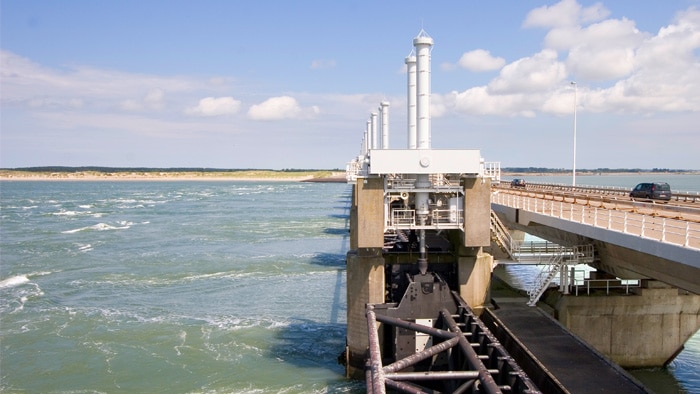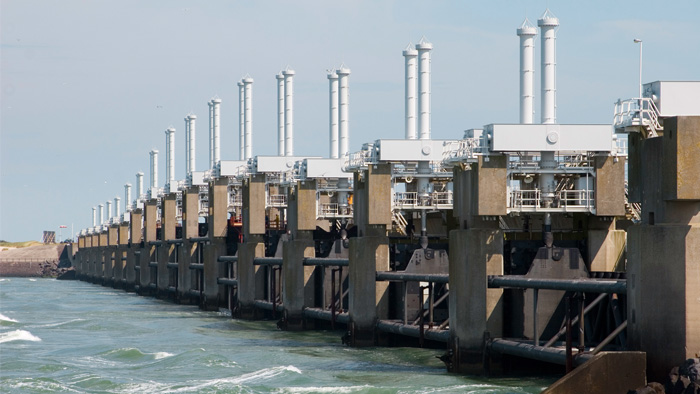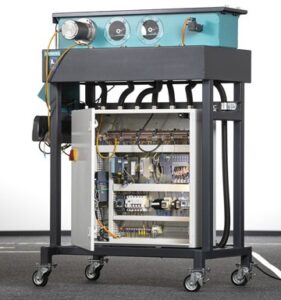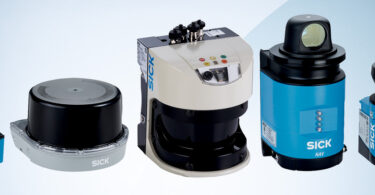SICK encoders monitor movement at the Oosterschelde storm barrier
For many years now, the Netherlands, and in particular the Dutch province of Zeeland, have been protected against North Sea high tides by the Delta Works. The Oosterschelde barrage has been playing an especially important role in this since 1986. When the water level in the North Sea rises rapidly, the 62 sluice gates of the barrage can be lowered within a short period of time. The gates can only function properly if their movements are perfectly vertical. These movements are monitored by encoders from SICK. After 25 years of trouble-free operation, the SICK encoders are now replaced by Siemens Mobility on behalf of the Rijkswaterstaat water authority. Siemens Mobility is installing new models, which SICK specially developed for the Oosterschelde barrage.
How exactly does the system work? The 62 sluice gates of the Oosterschelde barrage are attached on both sides to the piston rods of hydraulic cylinders. In turn, these piston rods are connected to pylons via universal joints. The gates are controlled locally by control computers. The individual gates are 45 meters wide and between 5 and 15 meters high. During all gate movements, encoders continuously measure whether the gates are moving straight. This check is extremely important because if the gates tilt, there is a risk of substantial damage to the pylons or the overall structure.
While minor deviations are permitted, the control computers immediately correct them by raising or lowering the individual piston rods by an additional amount suitable to the circumstances. The height on the North and South side of each gate are measured independently using three encoders mounted on each opposing edge of the gate.
Comprehensive testing, you say? SICK encoders pass 720-hour endurance test with flying colors
Siemens Mobility, Rijkswaterstaat and SICK systematically and rigorously prepared for the replacement of the encoders. The prototypes of the encoders—tailor made customer-specific versions from SICK—were first subjected to in-house testing at Siemens Mobility in Zoetermeer. Taking all the requirements of the Machinery Directive into account, the opening and closing of the gates was simulated in a specially developed rugged test rig. This means the encoders were subjected to a 720-hour endurance test.
“While carrying out these load tests, we also took into consideration that the voltage supply can fluctuate between 13 and 30 volts,” said Piet van Stee, Technical Manager at Siemens Mobility. “The encoders from SICK passed the in-house testing with flying colors. They reliably transmitted the expected values.”
From simulation to field: temperature fluctuations and sea water
After the simulation tests, it was time to commence the next step—field testing—in September 2020. To do so, Siemens Mobility installed six encoder prototypes directly into the Oosterschelde barrage. They replaced the original encoders on the opposite edges of three gates with new models. They then performed comprehensive tests during the storm season, i.e., until the end of April 2021.
In contrast to the in-house simulation environment, the encoders on the barrage are subjected to strong temperature fluctuations, sea water, and other environmental influences. The encoders are able to withstand these conditions.
“The specially developed encoders are resistant to the temperatures on the Oosterschelde barrage. Their housing is made from salt water resistant aluminum and they are largely insensitive to electromagnetic radiation,” said Maarten Braadbaart from SICK AG.

Expectations confirmed: no deviations
Rijkswaterstaat will soon systematically compare the values from the new encoders with the values from the existing encoders. The intermediate results obtained thus far confirm SICK’s expectations: no deviations were observed during the first months of test operation. And should deviations nevertheless still be detected?
“In this case we will, if possible, examine the situation on-site. Rijkswaterstaat can then decide whether to replace the affected new encoders with the old model again,” Van Stee said. “We will then investigate in our test rig whether the new encoder is defective. Should this be the case, it will be further analyzed by SICK.”
Fault-free operation for the long haul
If the test operation is completed with a positive overall result, Siemens Mobility will begin replacing all the existing SICK encoders with 372 of the new models. SICK has already prepared itself for the challenges this tight schedule will bring. Siemens Mobility will not only be responsible for replacing the encoders, but also for their maintenance over the coming twenty years. The maintenance tasks will also include regular inspections of the stock of 25 replacement encoders. These encoders need to be checked by Siemens Mobility every five years.
All hands on deck
Van Stee is pleased with the productive collaboration between SICK and the Rijkswaterstaat engineers.
“I enjoy working with clients who are on the same level as us technically. We jointly sought opportunities to push the technical limits,” Van Stee said. “Rijkswaterstaat was open to modifications when they were well founded. This close collaboration benefited all parties involved.”
A heart for Zeeland
The Oosterschelde barrage project was particularly special to Piet van Stee, not only because of its technical challenges, but because he himself hails from the Zeeland province. He feels a close connection to the Delta Works, recalling, “Our family, too, was greatly impacted by the disastrous flood in 1953. I witnessed the construction of the Oosterschelde barrage up close.”
“I am proud to have had the opportunity to manage this project from tendering through to implementation. Once the SICK encoders have been installed, I will trustingly hand over their maintenance to our Service department. Our qualified employees, with their wealth of knowledge, have been servicing the barrage exceptionally well for over twenty years now. In this way we, along with SICK, will ensure that the Oosterschelde barrage is operating reliably at all times,” van Stee said.
Want to learn more about SICK encoders? Contact us today!






